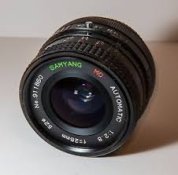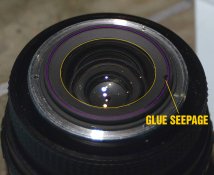M Carter
Member
I've got a 99 cent 28mm samyang lens in Nikon mount. Inside, it has the usual black steel barrel assembly with lens elements glued to the front and back. Anyone know how to remove the glue to pop an element out?
I'm not trying to repair the thing - heck, it looks like new; basically I want to strip the front coating and paint as much of the inner barrel spaces I can get to silver. If I destroy it, well... it's a pretty crappy consumer lens, only sharp around F11.
Why you ask? Well, I shoot a fair amount of music videos and I'm playing with organic effects... plastic lenses, making lenses from old elements and pipe, etc. I'm curious about a very reflective and uncoated lens for high key stuff, see what kind of flares and blurs might come from it. I've done some really pretty stuff by turning holga lenses into tilt housings, etc. Just looking for a pleasant surprise. I really like non-digital, skip the plugins kinds of things.
So, I'd like to pop the front element off to get inside the barrel. There's a steel ring and the glue seepage from assembly is very visible. Heat the metal with a soldering iron? Acetone soak? I'd rather not do something that makes the entire assembly fall apart (I've read about soaking the whole thing in solvent, etc). I don't care if it ends up with dust inside, etc.
The case it came with is a perfect fit for my bluetooth speaker that we use for synch on set, so this is already a win. Thanks for any ideas!
I'm not trying to repair the thing - heck, it looks like new; basically I want to strip the front coating and paint as much of the inner barrel spaces I can get to silver. If I destroy it, well... it's a pretty crappy consumer lens, only sharp around F11.
Why you ask? Well, I shoot a fair amount of music videos and I'm playing with organic effects... plastic lenses, making lenses from old elements and pipe, etc. I'm curious about a very reflective and uncoated lens for high key stuff, see what kind of flares and blurs might come from it. I've done some really pretty stuff by turning holga lenses into tilt housings, etc. Just looking for a pleasant surprise. I really like non-digital, skip the plugins kinds of things.
So, I'd like to pop the front element off to get inside the barrel. There's a steel ring and the glue seepage from assembly is very visible. Heat the metal with a soldering iron? Acetone soak? I'd rather not do something that makes the entire assembly fall apart (I've read about soaking the whole thing in solvent, etc). I don't care if it ends up with dust inside, etc.
The case it came with is a perfect fit for my bluetooth speaker that we use for synch on set, so this is already a win. Thanks for any ideas!




